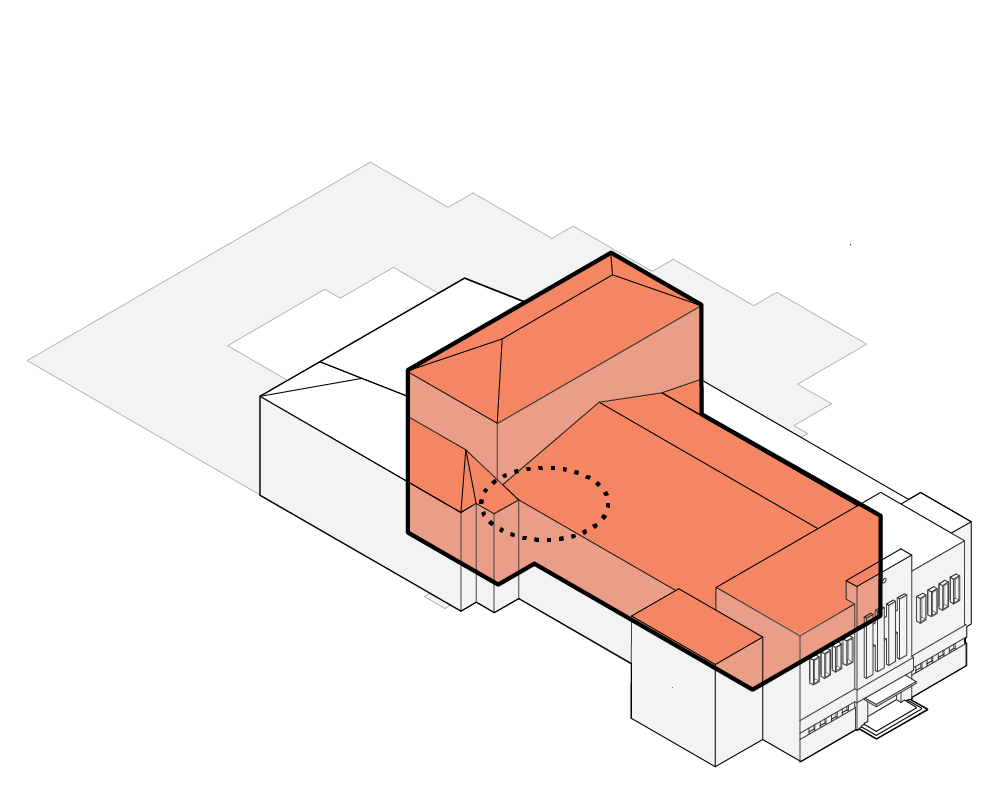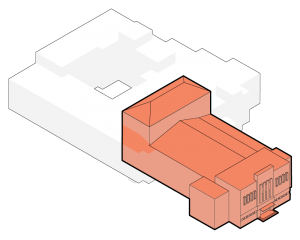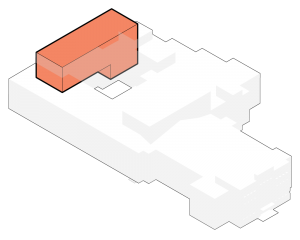








address
Tilžės g. 155
number of theatre staff
84
auditoriums
Big and Small
theatre building opened
1941
texts
Lina Sirtautė


The history of the current Šiauliai State Drama Theatre building begins not in Šiauliai, but in Kaunas, during the Interwar period. In 1935, engineer Antanas Breimeris designed a new, modern Kaunas cinema “Daina”, which was built and opened on the then Ukmergė highway (now Savanorių avenue). The building has an irregular rectangular plan and consists of three interconnected one- and two-floor buildings. There is a lobby on the front part of the building and a staircase on either side of the lobby, as well as a foyer in the south-west hall. However, the most architecturally valuable part of this building is its façade. The symmetrical modernist façade was created by the invited architect Stasys Kudokas.
A little later, the company “Pastogė” was established in Šiauliai, and started building a new cinema in Šiauliai, Tilžės Street, based on the project of Kaunas Cinema “Daina”. Here, the engineer and architect Karolis Reisonas contributed to the construction. Both “brother” buildings were decorated with almost identical façades: the main entrance with a folding wooden door was accentuated by a avant-corps rising above the roof with four vertical pilasters, densely spaced narrow windows framed by rectangular edges on both sides, at the top – the façade completed by a simple profile cornice, and the first and second floors were separated by a cordan.
However, in the end the cinema was never established in the newly built Šiauliai building, because it was passed to the drama theatre even before the construction was completed. At the time, the drama theatre did not have its own premises, and once a week it would use the “Kapitol” hall, adapted to the needs of both the theatre, and the cinema.
This Šiauliai Drama Theatre with a hall of 700 seats was opened on January 1, 1941.

After the Second World War, the Germans leaving Šiauliai set fire to the drama theatre building. After this, only the walls remained, but the façade did not suffer majorly. Restoration work began very soon, based on the project of the city’s chief architect Eduardas Budreika. It was not possible to restore the interior of the theatre, created by the architect Karolis Reisonas, but E. Budreika preserved the façade of the building and later this became a symbol of Šiauliai Drama Theatre.
Restoration work was difficult and slow. Only with 2-3 workers, assisted by the theatre actors themselves. Ironically, the Germans made a significant contribution to the reconstruction work too: the captives left in Šiauliai undertook skilled tasks – for example, they would design the required drawing on a piece of plain paper, later accurately executing it.
In the post-war period, it was common for construction materials to be in short supply or often to be stolen. Later, the manager of the Construction Association called the building defects report, written by the Chief of the State Architectural and Construction Control, a “novel” and commented: “Poorly laid floors and doors, you say? Rejoice. We could have not laid any floors or doors at all. „
Although the circumstances were not very favourable, the building of Šiauliai Drama Theatre also underwent a quantitative improvement during the reconstruction: small wings were added from the sides. Although the volume of the building took on a slightly different shape, the symmetry of the façade was not broken – the view from the front was filled with the same planes on both sides. And the inner space, which was previously asymmetrical, together with the annexes, gained symmetry: the north-east wing formed a second corridor along the auditorium – the same as the existing one, only on the other side of the hall. Thus, the lobby seemed to envelop the auditorium in the form of a „U”.

Although during the construction of the building the cinema project was adapted to a drama theatre – the stage expanded, backstage premises, props and decoration warehouses installed, and the building itself supplemented with side extensions during the reconstruction of the theatre after the fire, many things were still missing for completing all the needs of a drama theatre and its functions.
Throughout the decade, there were constant plans to improve the building of Šiauliai Drama Theatre. It is known that back in 1952, the then director of the theatre and the head of the Art Affairs Board wrote letters to the Republican Architectural Workshop asking to prepare an overhaul project for the theatre. The architect Apolonija Gugaitė-Nistelienė made the architectural planned task and the scheme of extension of the annexes and the stage. In 1962 the theatre was closed for an overhaul. During that time, Šiauliai Drama Theatre was equipped with a rotating stage and lighting wings, new chairs were built in the auditorium.
The installation of a stage wheel almost 10 meters in diameter in Šiauliai Drama Theatre was slightly different than in other theatres. Probably, the wheel tracks were installed on the demolished stage floor right on the basement floor. When the stage floor was re-laid, the rails became inaccessible neither from above nor from below (e.g. for repairs). After all, the original project of the building was intended for a cinema and did not provide neither a stage nor, moreover, a spacious basement for maintenance around the entire perimeter of the stage.

Often theatre guests and spectators do not even realize that many theatre buildings are much larger, that the theatre has not only „visible” and public spaces – a lobby, a foyer, a cafe and halls, but also many other spaces for theatre staff only: workshops, warehouses and other auxiliary premises. This technical part of the building is very important for the comfortable functioning of the theatre and often occupies an even larger part of the total area of the theatre building.
However, Šiauliai Drama Theatre staged its performances in the new building for almost four decades, with only a very small workshop and just a few auxiliary rooms. Finally, in 1976, the architect Virginija Taujanskienė prepared the later implemented project of the annex of Šiauliai Drama Theatre. During the reconstruction of the building, which lasted a couple of years, an extension of about 1,500 m2 was added to the theatre from the side of Varpo Street, for industrial premises. It provided over 50 rooms for various purposes: rooms for directors, actors, artists, props, decoration workshops and warehouses, as well as a large rehearsal room where performances could take place.
The annex is cleverly designed – it seems it encloses the back of the existing building, forming not only the necessary premises, but also very important connections between them. For example, in the north-eastern part, metal and carpentry workshops are planned next to each other, from here – a direct connection with the painting workshop, and further – high doors, through which the prepared decoration is transferred directly to the stage. These rooms are spacious and have large windows that let in plenty of natural light. Further from the stage, again through high doorways (about 8 m!), The scenery travels to a warehouse in the north-western part of the annex. From this room there is an exit directly to the inner courtyard, the space of which is closed by a garage, thus making it convenient to prepare for tours.

Over time, the Great Hall of the Šiauliai Drama Theatre and its lobby have undergone transformations.
The original interior, designed by architect Karolis Reisonas, was lost after the war, during a fire. However, the old style of socialist realism was still followed in the restoration of the interior – the hall is decorated with splendour. This is evidenced by the luxurious chandelier hanging in the centre above the ground floor.
The great lobby, formed after the reconstruction of the building as two corridors, which together with the connecting part form the letter „U”, is a modern take on the theatre lobby. Nor is the importance of stairs traditionally used in theatres here. Although on both sides of the lobby there is a staircase, the stairs of which are decorated with polished granite steps, none of them is dominant.
In 1979, the architect A. Bučinskaitė designed the interior design of the auditorium and lobby. After its implementation, there was no chandelier left in the great hall, and perimeter linear lighting was installed in its place – a modern solution at that time. In addition, side balconies were additionally designed.
In general, A. Bučinskaitė’s decisions were ambitious, but not entirely well-received. It was said that the installation of the theatre became more interesting, but other architects showed a reserved reception of it. The materials used were not as effective as desired: the metal panel and the mirrored ceiling in the central part of the lobby did not create the impression of a larger space, but rather compressed it.
The last renovation of the interior of the Great Hall and its lobby took place in 2017, the author of the project was interior designer Martynas Olšauskas. During the renovation, the mirrored ceiling in the lobby was dismantled, but authentic relief ceilings remained in the lobby corridors. In order to create a elegant image of the theatre, grey colours were chosen, combining them with dark wood pattern decor. The granite slab floors and stair treads were also preserved. The lobby is still decorated with V. Trušis’ allegorical diptych “Tragedy” and “Comedy”, although the two mosaics are not visible together because they are separated by the auditorium.
Replacing the chairs with a different model, the Great Hall now seats almost 400 spectators.

After the annex of the Šiauliai Drama Theatre was built and more than 50 auxiliary rooms were planned in it, one of them was assigned for rehearsals. For the theatre troupe, this spacious room became a significant facilitator of their daily work. Performances could also take place in this rehearsal hall – therefore, it was named the small stage.
In order to properly assess the importance of the appearance of the small hall, it is necessary to remember the history of Šiauliai Drama Theatre. Since its founding, for a long time the troupe was creating and performing with virtually no space. Initially, the theatre rented the hall of the “Kapitol” cinema and was allowed use it once a week, and although its scene was only minimally adapted for performances, the troupe still had to rehearse and perform in completely random spaces on other days. The situation changed when the new building went to Šiauliai Drama Theatre – it is true that it was also a cinema project adapted for the drama theatre. It had only one hall with a stage and some essential auxiliary rooms. And only after the construction of the annex, the building of Šiauliai Drama Theatre could be called full-fledged.
An experiment was conceived in 1980. Architect R. Šileika designed the theatre studio in the former Jesuit church on Vilniaus Street. The object was even called the Small Theatre, it had an hall – an 80-seat amphitheatre, a small lobby and a buffet. This experimental space lasted for five years before the building was returned to its real owners, the Jesuits.
But it is only now, in the last five years, that the small hall has been completely occupied. Not only its interior was renewed, but also its technical base: lighting system, a new telescopic chair system, etc. It is due to the unfolding and folding system of spectator chairs, the small hall can be adapted for various activities: performances, rehearsals and other events.

The Šiauliai Drama Theatre Palace, built in 1938, was characterized by simple and laconic architectural aesthetics. The façades of the building were dominated by blind planes, and the façade that stood out the most in the composition, was the main one, oriented towards Tilžės Street. Its centre was accentuated by a slight avant-corps, and the façade was dominated by the rhythm of pilasters and vertical high windows. The theatre building is retracted to the depths of the plot, thus forming a small and cosy public space that enlivened the perimeter of the street at that time.
And although the façade of Šiauliai Drama Theatre was considered an iconic symbol of the theatre, in 2014 its architectural expression was changed. The doors of the main entrance were simplified – the former oak was replaced with glass in a plastic frame, the avant-corps was framed with added volume, and the former delicate scale of the roof took on a semi-circular shape. The latter details are trimmed with dark brown metal plates. The colour of the building plaster was also changed – a combination of light and darker brown tones was chosen.
According to the project prepared by UAB TS Projects (architect Osvaldas Jankauskas), the renovation of the theatre building was done to insulate it. Although only at the beginning, there were public protests. At that time, it became clear that the solutions of the project had never been made public and agreement was made only between the client and the project architects. However, there were no legal arguments to stop the future loss of the authentic interwar period façade: the Šiauliai Drama Theatre building is not in the Register of Cultural Heritage.
Today, it can be summarized that the “twin” buildings had different destinies: the cinema “Daina” in Kaunas is recognized as valuable (i.e. entered in the Register of Cultural Heritage), even though it is out of use and abandoned for many years; o The building of Šiauliai Drama Theatre is still used in active cultural life, but as if it was underestimated and less valuable.
Tumkevičius, K., Šiaulių dramos teatras. Vilnius: Mintis, 1981.
Markevičiūtė, E., Šiaulių dramos teatras 1931-1991. Vilnius: Vaga, 1992.
Sabaliauskas, S., Šiaulių dramos teatras. Vilnius: Dominicus Lituanus, 2011.
Daina (kino teatras) [interaktyvus]. [žiūrėta 2021-10-13]. <https://lt.wikipedia.org/wiki/Daina_(kino_teatras)>
Jastromskaitė, J., Kino teatras „Daina“ [interaktyvus]. 2018 [žiūrėta 2021-10-13]. <https://modernizmasateiciai.lt/kino-teatras-daina/>
Surblys, A., Kauno kino teatrai 1918-1940 m.: lokalizacija ir raida [interaktyvus]. 2011 [žiūrėta 2021-10-13].
<https://www.vdu.lt/cris/bitstream/20.500.12259/31901/1/ISSN2335-8734_2011_N_11.PG_151-197.pdf>
Oniščik, M., Kaunas nykstantis ir išnykęs: kino teatras „Daina“ (Savanorių pr. 74) [interaktyvus]. 2018-04-27 [žiūrėta 2021-10-13]. <http://marijosblogas.blogspot.com/2018/04/kaunasnykstantis-ir-isnykes-kino.html>
Valstybinis Šiaulių dramos teatras, Teatro salės [interaktyvus]. [žiūrėta 2021-10-13]. <http://www.vsdt.lt/teatro-sales/>
Valstybinis Šiaulių dramos teatras, Apie teatrą [interaktyvus]. [žiūrėta 2021-10-13]. <http://www.vsdt.lt/apie-teatra/>
LRT PLIUS laida „Stop juosta“, Tarpukario Šiauliai: Baltieji rūmai, kairuoliškos pažiūros ir įspūdinga pramonė [interaktyvus]. 2020-12-20 [žiūrėta 2021-10-13]. <https://www.lrt.lt/naujienos/kultura/12/1301128/tarpukario-siauliai-baltieji-rumai-kairuoliskos-paziuros-ir-ispudinga-pramone>
Teatrai.lt, Šiaulių dramos teatras [interaktyvus]. [žiūrėta 2021-10-13]. <http://www.teatrai.lt/teatrai/siauliu-dramos-teatras/id-35>
BNS, Keičiamas Šiaulių dramos teatro pavadinimas [interaktyvus]. 2014-10-20 [žiūrėta 2021-10-13]. <https://m.kauno.diena.lt/naujienos/laisvalaikis-ir-kultura/kultura/keiciamas-siauliu-dramos-teatro-pavadinimas-655270>
Valstybinis Šiaulių dramos teatras, Teatro salė uždaroma remontui [interaktyvus]. 2017-05-17 [žiūrėta 2021-10-13]. <http://www.vsdt.lt/news/143/61/Teatro-sale-uzdaroma-remontui/>
Šiaulių „Aušros“ muziejus, Šiaulių dramos teatras [interaktyvus]. [žiūrėta 2021-10-13]. <https://museum4u.lt/siauliu-dramos-teatras/>
Šiaulių bulvaras [interaktyvus]. [žiūrėta 2021-10-13]. <https://lt.wikipedia.org/wiki/%C5%A0iauli%C5%B3_bulvaras>
Mankus, M., Vilniaus gatvė – pėsčiųjų alėja Šiauliuose (Išlikęs) [interaktyvus]. [žiūrėta 2021-10-13]. <http://www.autc.lt/lt/architekturos-objektai/1989>
Kultūros vertybių registras, paieška: (2624) Kino teatro „Daina“ pastatas [interaktyvus]. [žiūrėta 2021-10-13]. <https://kvr.kpd.lt/#/static-heritage-search>
Aleksaitė, I., Lietuvių teatro istorija. Antroji knyga 1935-1940. Vilnius: Kultūros, filosofijos ir meno institutas, 2002.
Žadeikytė, R., Teatro fasadas keičiamas „euroremontu“, Šiaulių kraštas, 2014-12-19 (246(6919)).
Valstybinis Šiaulių dramos teatras paminėjo 85-erių metų veiklos jubiliejų [interaktyvus]. 2016-09-28 [žiūrėta 2021-10-13]. <https://siauliugidas.lt/valstybinis-siauliu-dramos-teatras-paminejo-85-eriu-metu-veiklos-jubilieju/>
Vitkus, R., Scenos riteriui Pranui Piaulokui atminti – paroda teatro fojė [interaktyvus]. 2015-06-02 [žiūrėta 2021-10-13]. <https://www.lrytas.lt/kultura/scena/2015/06/02/news/scenos-riteriui-pranui-piaulokui-atminti-paroda-teatro-foje-3652674/>
Ramaneckienė, I., 12 13.Akmens mozaikos – reikšmingiausi Vitolio Trušio tapybos darbai [interaktyvus]. [žiūrėta 2021-10-13]. <https://www.aidas.lt/lt/kultura/article/15676-12-13-akmens-mozaikos-reiksmingiausi-vitolio-trusio-tapybos-darbai>Žadeikytė, R., Kodėl architektūros istorija naikinama kultūros žmonių rankomis? [interaktyvus]. 2014-12-27 [žiūrėta 2021-10-13]. <http://old.skrastas.lt/?data=2014-12-27&rub=1065924810&id=1419354850